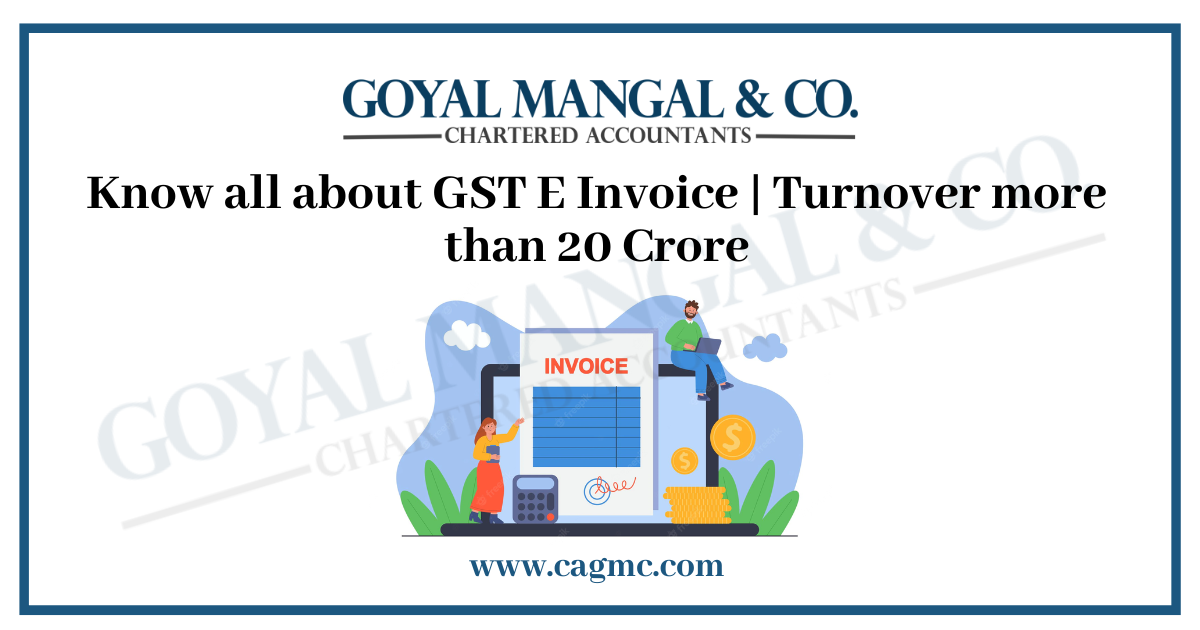
The e-invoicing system is now applicable to more businesses through CBIC Notification CGST 01/2022 dated 24 February 2022. Indian businesses with an annual aggregate turnover of more than Rs 20 crore to Rs 50 crore as calculated in any previous financial year from 2017 onwards -18 to 2021-22, must start generating e-invoices from April 1, 2022. This article focuses on all about GST E-invoicing for businesses with turnover more than 20 crore.
|
Table of content |
Who must comply with E-invoicing as per the roadmap?
During the first phase, Indian businesses with a turnover of more than Rs 500 million had to generate e-invoices from 1 October 2020. In the next phase, businesses with a turnover of more than Rs 100 million started issuing e-invoices from 1 January. 2021. In the third phase, businesses with a turnover of more than Rs 50 crore had to generate e-invoices from April 1, 2021. A total of 2,40,567 business firms came under this turnover category.
After a year, the government wants to expand the massive scheme to around 1,80,000 more Indian firms from April 1, 2022. These mid-sized firms fall within the turnover range of Rs 20 crore to Rs 50 crore in any financial year between 2017-18 to 2021-22. The official noted that the government is predicting a 75% increase in GST registration due to the move.
E-invoicing impact on business processes
From the notification, the relevant businesses have only one month to prepare for the system. Businesses must now integrate their systems with the government’s Invoice Registration Portal (IRP) to seamlessly generate an Invoice Reference Number (IRN) for each B2B invoice. They need to get their accounting software to adapt to the changes to accommodate the e-invoicing scheme.
The generation of electronic invoices will affect business processes as follows:
- The business now needs to identify the transactions that are subject to e-invoicing and separate them from others in order to comply with the regulations.
- Relevant businesses must maintain supplier and customer master data to include additional billing details such as GSTIN, bank account and payee details to ensure accuracy.
- Businesses need to change their GST return filing process as B2B supplies will be automatically populated in returns and B2C supplies will be updated manually.
- Businesses need to decide whether they want to follow e-invoicing through API integration or use offline tools like GePP and integrate directly or through a GST Suvidha Provider (GSP).
- The biggest challenge businesses can face is engaging in real-time generation and capture of IRNs. Retailers of this turnover scale issue thousands of B2B invoices every day. They can’t make customers wait that long until the e-invoice is generated. Such enterprises must use the services of GSP for smooth implementation.
E-invoicing process
E-Invoicing requires you to generate billing data in a prescribed format (JSON), either using ERP/business management software or an offline tool provided by the portal. And then upload it to IRP, which will then validate and verify the invoice data using the IRN and QR code.
The process of generating an e-invoice is given below:
- Generate e-invoice in prescribed format using software solutions/business management software or use offline tool provided by portal
- Log in and upload the electronic invoice file to IRP. If the software is integrated with IRP through GSP, the upload of the JSON file will be automated, which means that the system will send the required data directly to the IRP portal.
- The IRP portal verifies the key elements of the invoice and after successful verification, the invoice data is authenticated using the IRN number and QR code
- You can also download or receive an electronic invoice file along with the IRN for the invoices you have uploaded. Use the received data to update your invoice with the IRN number and QR code. In the case of an integrated ERP and IRP environment via GSP, the software automatically reads and prints such details.
Consequences of not generating a E-invoice
Failure to generate an electronic invoice is considered an offense and is subject to penalties. Non-compliant businesses have to pay strict penalties set at Rs 10,000 for each invoice. In addition, inaccurate invoicing can lead to a fine of Rs 25,000 for each invoice.
In addition to the penal provisions, if a taxpayer delays the generation of an e-invoice, it may lead to
- GST returns are not auto-populated.
- Customers cannot claim eligible ITC.
- Customers refuse to accept an invoice that does not comply with the electronic invoicing provisions.
Conclusion
If you are a company with an annual turnover of 20 million crowns or more, an electronic invoice will apply and you must electronically upload all B2B and B2G invoices to the portal. The electronic invoice needs to be generated in the required format and uploaded to the IRP portal. The IRP portal will verify the invoice data and return the file with the IRN and a digitally signed QR code.


